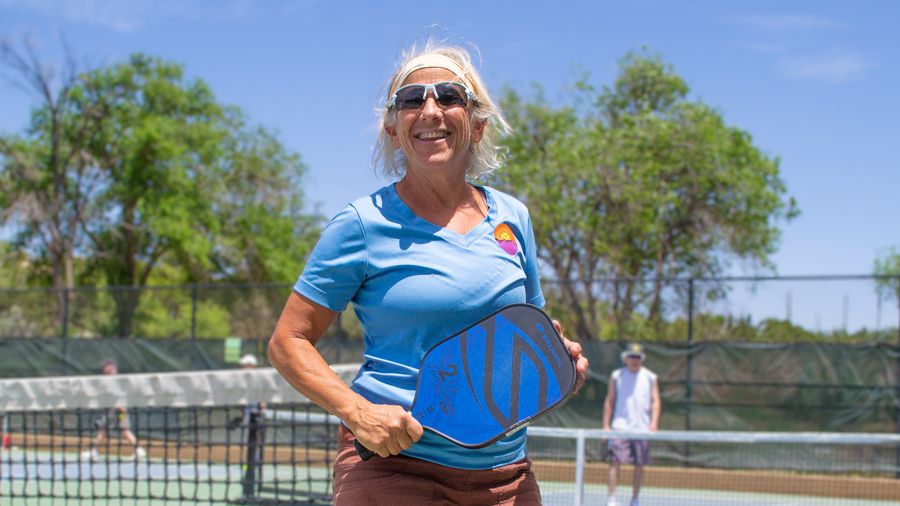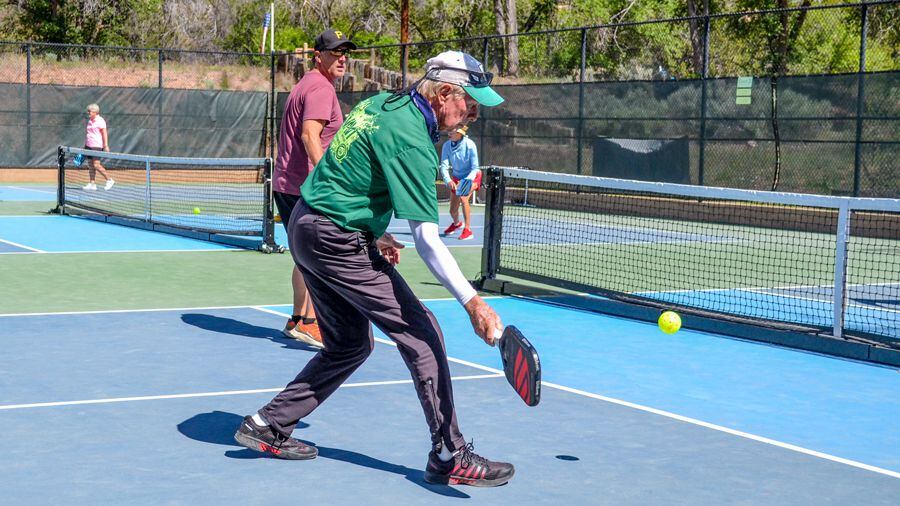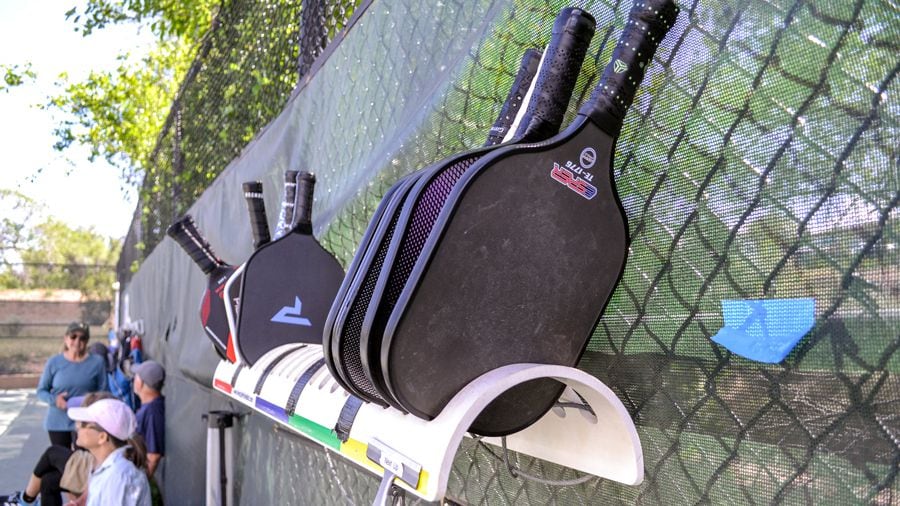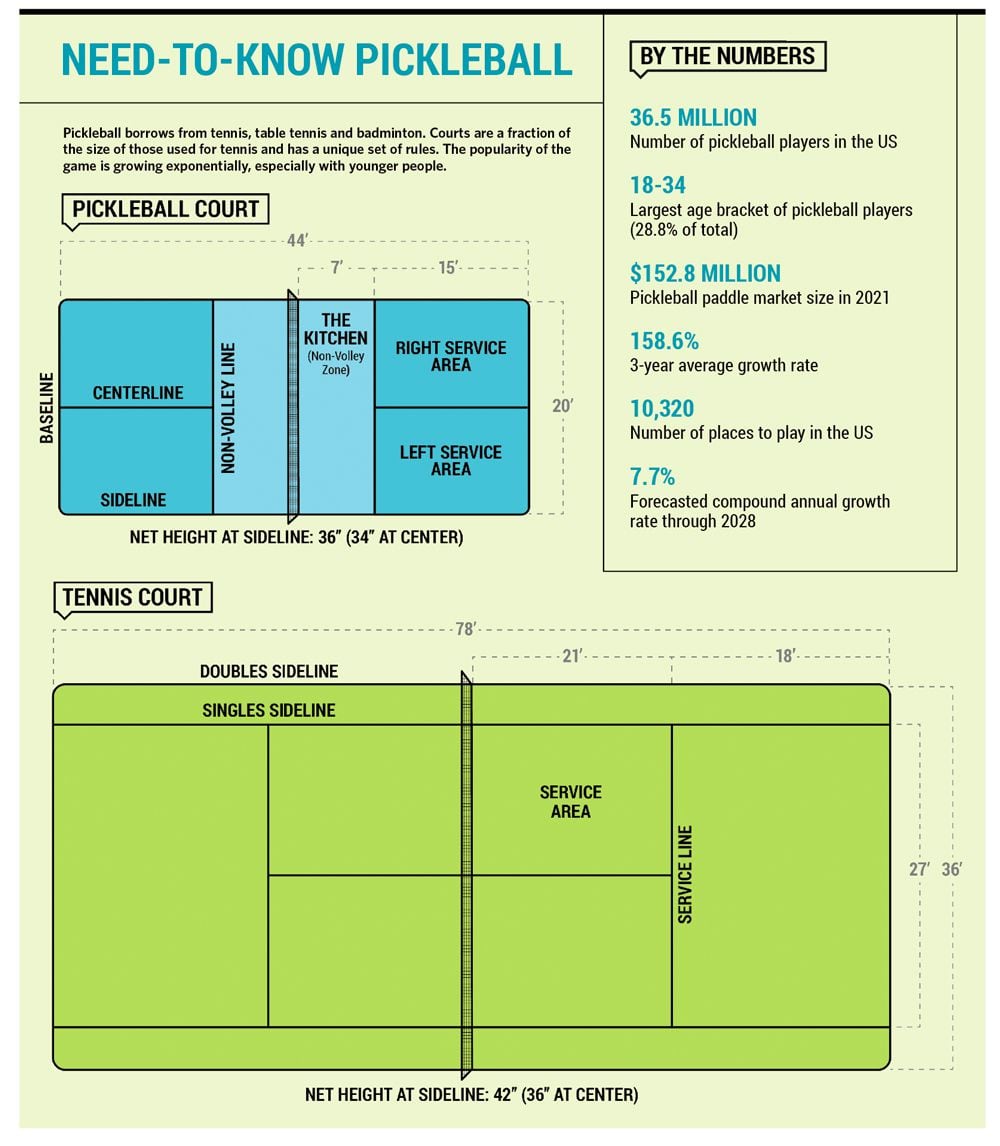On a recent Thursday at Fort Marcy Park, at what was once designated tennis courts, the sound of hard plastic balls hitting paddles and the ground fills the air—echoes of something like popcorn popping.
Sports bags, water bottles and paddles line the fences as players of varying ages take part in the nation’s latest sports craze: pickleball.
Despite the game’s reputation as a softer and less intense version of tennis, players appear sweaty and focused. Yet, they’re considerably more chatty, generally, than players of the more traditional sport. The balls resemble whiffle balls, but with more holes. The paddles look like those used to play table tennis, but bigger. By 9 am, the courts have come alive with dinks, volleys, chit chat and laughter. Within an hour, 24 people are playing and at least another dozen wait to jump in on a game. Santa Fe Pickleball Club President Cindy Lawton tells SFR courts never stand empty.
“It’s pretty much full all day, every day,” she says.

Santa Fe Pickleball Club President Cindy Lawton can be spotted nearly every morning at the Fort Marcy courts. (Andy Lyman/)
Pickleball has elements of tennis, table tennis and badminton. Players say it’s easier on ankles, knees and shoulders, yet scoring can become a little confusing. Often viewed as a way for grandparents to participate in gentle exercise and keep the old ticker going, pickleball can still wear out even the most active of athletes. In just a few years, pickleball has grown exponentially across the country with countless news stories to prove it. As it creeps up in popularity, Santa Fe has pickleball fever and more courts might be the only cure.
After converting the Fort Marcy courts to accommodate pickle-heads with a ribbon cutting in September 2021, the City of Santa Fe paid a firm to design six new courts at the park, using funds paid by pickleball groups. Devoted players are hoping that expansion might help put Santa Fe on the pickleball tournament circuit, while others are just happy there’s a new game to play.
The sport that has everyone talking was invented in the 1960s by the family of former Washington Lt. Gov Joel Pritchard. As the story goes, Pritchard’s kids were bored, so he tasked them with coming up with a new game. After grabbing some table tennis paddles and a whiffle ball, pickleball was born. Pritchard’s wife Joan is said to have come up with the name, inspired by pickle boats, which, in the world of competitive rowing, are crewed by those not selected for more elite teams. Specialized pickleball paddles and balls emerged as the sport evolved.
At Fort Marcy, modern, carbon fiber paddles line up in a rack mounted on the fence, denoting which player is up next. On a typical day, a club volunteer serves as a host and greets both newcomers and familiar faces and keeps an eye on the player queue. When players want to jump in, they stick their paddles in the rack and as people take a break or call it a day, the new players rotate in.

John Cunningham, a member of the Santa Fe Pickleball Club, lobs a ball during open play at Fort Marcy. (Andy Lyman/)
Annie Maes, who was an avid tennis player until she tore her rotator cuff in 2020, acted as the court hostess the day SFR visited. She says in the few years since she swapped a racquet for a paddle, she’s advanced to the same level in pickleball as when she played tennis.
“I know it has the funny name. I know everybody says, ‘Oh, it’s just for old people,’” she says. “Let me tell you, it’s not just for old people. I had so much fun learning and now I’m competing.”
Many local players recall having the same misconceptions regarding the sport before they picked up a paddle.
Santa Fe artist and filmmaker Michael Barnard says he grew up surfing in California, but after a stint in Iowa, he discovered pickleball—although he admits he wasn’t enthusiastic about it at first.
“I saw these old people playing pickleball, and thought, ‘That’s ridiculous,’” Barnard says. “But then I started and went, ‘This is kind of fun.’”
Even former Lt. Gov. Diane Denish is getting in on the action, although mostly in Albuquerque. She also says she had some preconceived notions about a sport played on a shrunken tennis court that uses oversized ping pong paddles.
“I think the misconception, early on for me, was pickleball is for people over 60, or 65,” Denish says. “It’s actually very, very multi-generational. I’ve played with kids as young as 12 and 13—I play with my grandchildren—and I’ve played with people in their 80s.”
Rancho Viejo resident Richard Eikelenboom is originally from the Netherlands and was hoping to find a place to play badminton, a sport he played competitively before he moved to the US, and one he says is more intense than many Americans realize. Eikelenboom says badminton was a no-go here.
“There’s like four people playing [badminton] in Santa Fe,” he says.
Now Eikelenboom spends about three mornings a week at Fort Marcy. Lawton, however, shows up nearly every day.
Her trajectory into pickleball illustrates the sport’s rapid growth, both in New Mexico and nationwide. She went from pickleball novice to president of the Santa Fe Pickleball Club in a little more than five years.
She started playing after a family visit to Canada when her aunt introduced her to the game. When she came home, there still wasn’t a notable pickleball presence in the city. After returning from another trip north to see her aunt, Lawton was hooked and joined the Pickleball club. By 2022, she became the club’s president.
Lawton laughs at the notion that six full courts—with four people each—and another five or six waiting to jump in, seems like a busy morning. She says there have been times when there are upwards of 50 people waiting for a turn and the mounted paddle area used as a queue fills up, so people have to start lining up paddles on the ground below.

Players at the Fort Marcy courts use their paddles to queue up for the next game. (Andy Lyman/)
Lawton hopes the six-court expansion will lead to regional tournaments and a boost in tourism dollars. But she has her sights on even more courts for nationally sanctioned tournaments.
“The USA Pickleball Association recommends one court in your location for every 5,000 people at this time, so our long-term goal is to have 30 courts,” she says.
When asking the city government for court conversions and expansions, it helps to have a fan on the City Council. Councilors Carol Romero-Wirth and Signe Lindell were instrumental in convincing other officials, including Mayor Alan Webber, to approve the concept.
Romero-Wirth discovered pickleball about four or five years ago while on vacation with her family. When she came home, she started taking stock of what Santa Fe had available, which wasn’t much at the time. In an absence of true pickleball courts, sometimes players will mark new lines on existing tennis courts, which can get dicey and in one case landed a Denver septuagenarian behind bars.
“I talked to the mayor about it and said, ‘We really ought to see what we can do for pickleball,’” Romero-Wirth says. “And then, lo and behold, there was a club forming.”
Parks and Open Space Director Melissa McDonald tells SFR the city used operational money—less than $20,000—to resurface and reconfigure the courts into dedicated pickleball courts in 2021, making them the only public spot not shared with other activities.
The Santa Fe Pickleball Club and the Mammel Family Foundation donated $50,000 each toward the design cost for additional courts at Fort Marcy. A city resolution accepting that cash also directs city staff to designate capital improvement funds for the project. McDonald tells SFR the design contract will provide a detailed cost estimate for the construction, but the city already has a $650,000 Legislative appropriation on the way from the 2023 session.
Romero-Wirth says between her day job as a lawyer and her duties as a city councilor, she doesn’t have a ton of time to practice her serving skills, but she still looks forward to the pick-up games with her kids and husband state Senate Majority Leader Peter Wirth, D-Santa Fe, when she can.
“It’s a great family game,” she says. I’ve played with my mother and her husband—they’re in their 80s—and my kids and Peter. There’s three generations right there, and we can all enjoy the game together.”
Romero-Wirth says she hopes adding more pickleball courts will increase community engagement in a fun and healthy way and that drawing national tournaments will be an added bonus.
“I’m excited for what we’re able to do for the community that’s here and for people who are visiting,” she says. “If we get a tournament, to me, that’s kind of a bonus, that’s gravy, that’s icing on the cake. But that’s certainly not why I have been supportive.”
Making Santa Fe a pickleball tournament stop could end up being a byproduct instead of the main goal, but McDonald says pickleballers are rearing and ready to go.
“This is going to put Santa Fe on the competitive map and allow us to have some real tournaments here, which I know the pickleball community in particular is very excited about,” McDonald says.
For context, Albuquerque saw an influx of visitors a few years back, partially thanks to pickleball.
Angie Jepsen, director of Sports Development for the Albuquerque Sports Commission, a division of the nonprofit Visit ABQ, says the city’s 18-court Manzano Mesa Pickleball Complex was one of the reasons Albuquerque was selected for the 2019 Senior Games, which “brought in over 12,000 athletes to participate in 20 unique sports, including 1,200 attendees for the pickleball championships.”
McDonald says converting the Fort Marcy courts was a necessity after pickleball’s popularity started to grow.
“We were finding ourselves, and still are, in a situation where, on many days we have 50-plus people showing up at our pickleball courts within the city,” she says, adding that even now the Fort Marcy conversion was a “band-aid measure,” considering the sport is “just truly exploding in terms of demand.”
McDonald says part of her strategy is to continually improve existing tennis courts while also creating dedicated space for paddle slingers.
“We’ve gotten very few complaints. People were very happy with that,” she says. “So I think it was a really good call, and I think everybody’s excited that pickleball is happening.”
Even with the six devoted courts at Fort Marcy, pickleballers are finding shared space wherever they can.
The gym at Fort Marcy occasionally hosts indoor pickleball, as does the Santa Fe Community College. The Genoveva Chavez Community Center devotes its gym to indoor pickleball a couple times a week and courts at Salvador Perez Park have lines painted for both tennis and pickleball, but the space is predominantly used for tennis.
Both The Club at Las Campanas and the Santa Fe Tennis and Swim Club have dedicated pickleball courts, but both require a membership. The Forked Lighting Racquet Club, expected to open in 2024 off Rodeo Road, will also have dedicated pickleball courts for members.
Santa Fe County broke ground in May on a Romero Park expansion that will include five more pickleball courts in the Village of Agua Fría.
Even though the governments and private companies are rapidly adding courts, it still may be hard to keep up with demand. Maes says she’s getting antsy and having trouble patiently waiting for the new courts at Fort Marcy.
“It’s just not fast enough, for my money,” she says.
It might seem odd, considering the consternation that comes with sharing sports facilities in Santa Fe, that pickleball and tennis players can coexist copacetically. But Lawton says it wasn’t always that way.
“Sometimes we’d have like 12 people waiting to play pickleball with two tennis people, and we’re like, ‘Could you move over to the other tennis court where there were no pickleball lines?’ And they said, ‘No, we were here first,’” Lawton says.
Even though pickleball borrows from tennis, there’s been a mixed response from players and fans of the latter. Caitlin Thompson, co-founder of the tennis lifestyle magazine Racquet, told The New York Times that she sees pickleball as no different than flashes in the pan such as cryptocurrencies and NFTs. But other tennis players are embracing the increasingly popular sport. Tennis greats John McEnroe, Michael Chang, Andre Agassi and Andy Roddick competed in a pickleball tournament in January, which led to Agassi and Roddick walking away with the $1 million purse.

The public in general sometimes pushes back against pickleball. The balls, which resemble whiffle balls (but to be clear they’re not, so don’t call them that) make a distinct popping sound that seems to grate on some people’s nerves. Neighbors near a group of Denver pickleball courts complained about the racket the paddles and hard plastic balls create, for example.
The voices of pickleball are also a little louder than tennis, partially because of the sociable nature of the game. Opposing players or teams are much closer together, which makes it that much easier to have a friendly—albeit sometimes winded—conversation. Noise issues don’t seem to be a problem in Santa Fe, yet.
The game continues to gain momentum. According to Pickleheads.com, the number of pickleball players increased by nearly 160% in the past three years, making pickleball the fastest-growing sport in the US, right behind cycling and running. National competitions are serious business and there’s an emerging paddle racket too: Ben Johns, the top-rated men’s singles pickleball player in the US, has his own signature paddle that goes for a cool $250.
Anna Leigh Waters, who’s leading the pack in women’s single play at 16, seems to also confirm that it’s not a sport relegated to grandparents.
Even as fast as the sport is spreading in the City Different, it has a way to go compared to other cities and states.
Seattle, where the sport originated, is dominating when it comes to the number of available courts, with 49 spots to play. Even Tucson, the city with the tenth-most number of courts, boasts 29 places to play. Texas as a whole has almost 520 places to dink and ranks third in the nation for the number of courts.
Still, the pickleball scene is expanding in Santa Fe faster than the city can devote space. Lawton says club membership increased from 200 to 500 people in one year. The rapid spread of the sport might be attributed to the fact that nearly everyone who plays tries to recruit others at any chance they get. Lawton says it’s an easy sport to learn, even with its complex scoring.
“I tell people, ‘Don’t worry about it until you play five times, and just ask somebody to help you,’” she says.
Romero-Wirth can’t seem to praise pickleball enough.
“I just think it’s a great sport,” she says. “I’m very enthusiastic about it and it makes me smile.”
